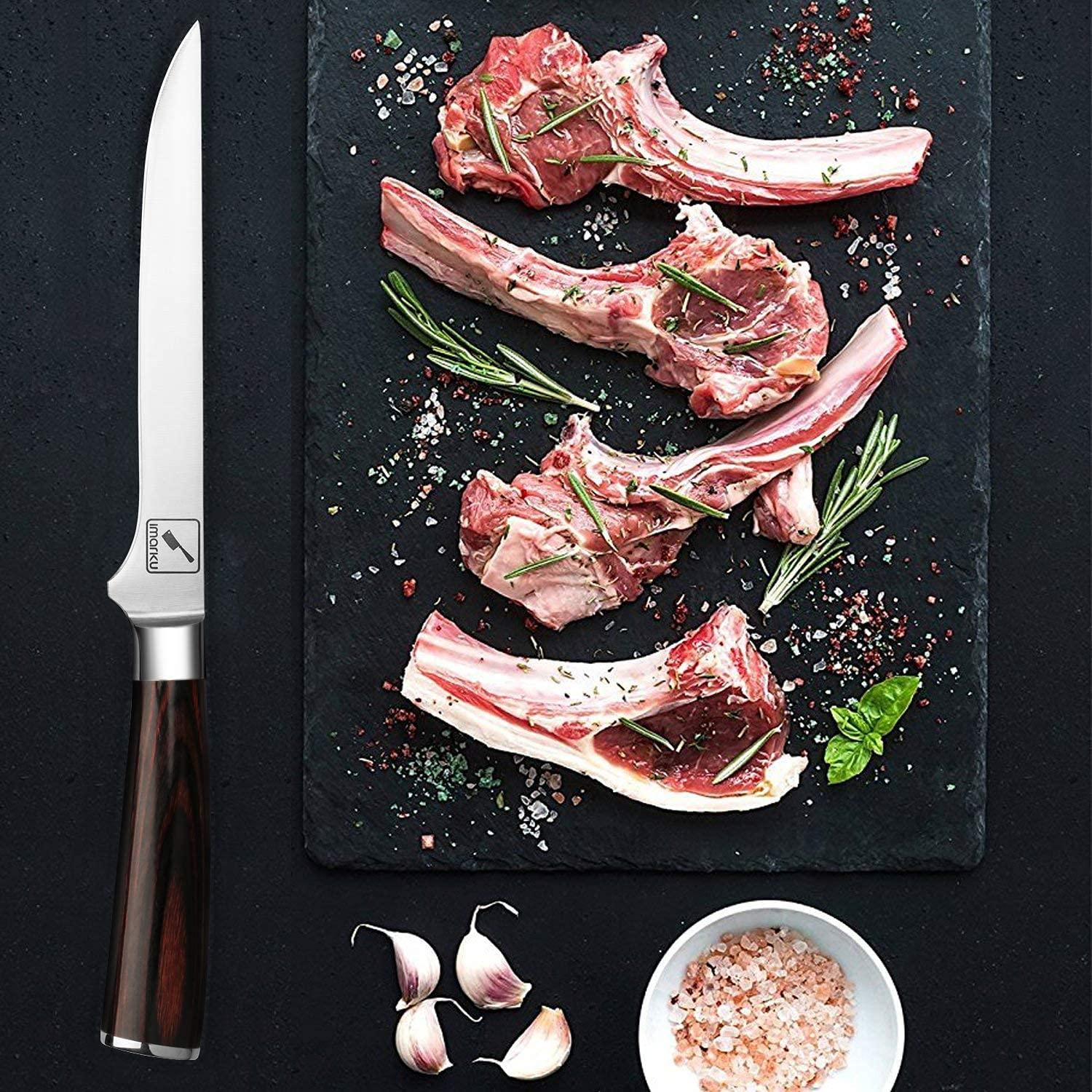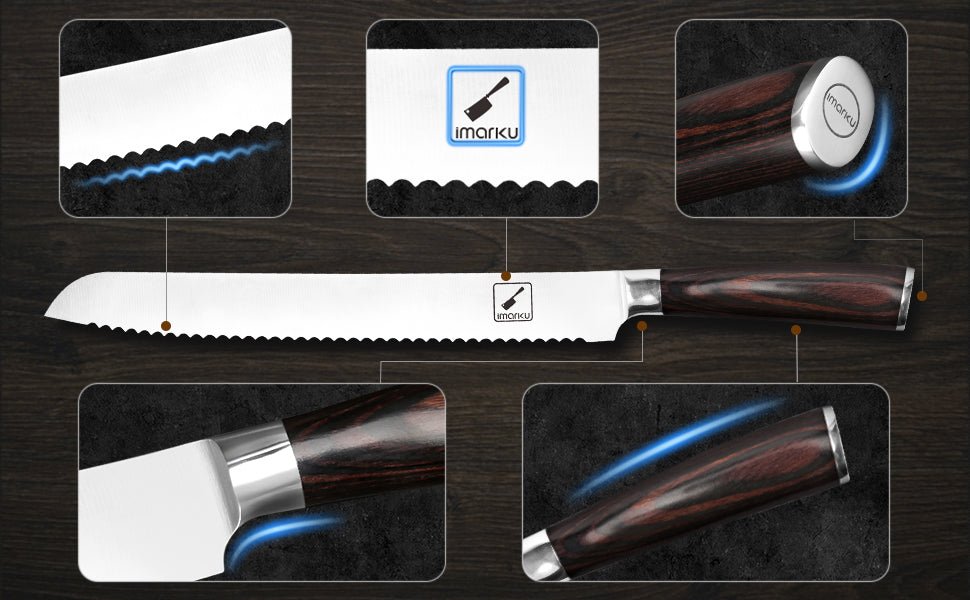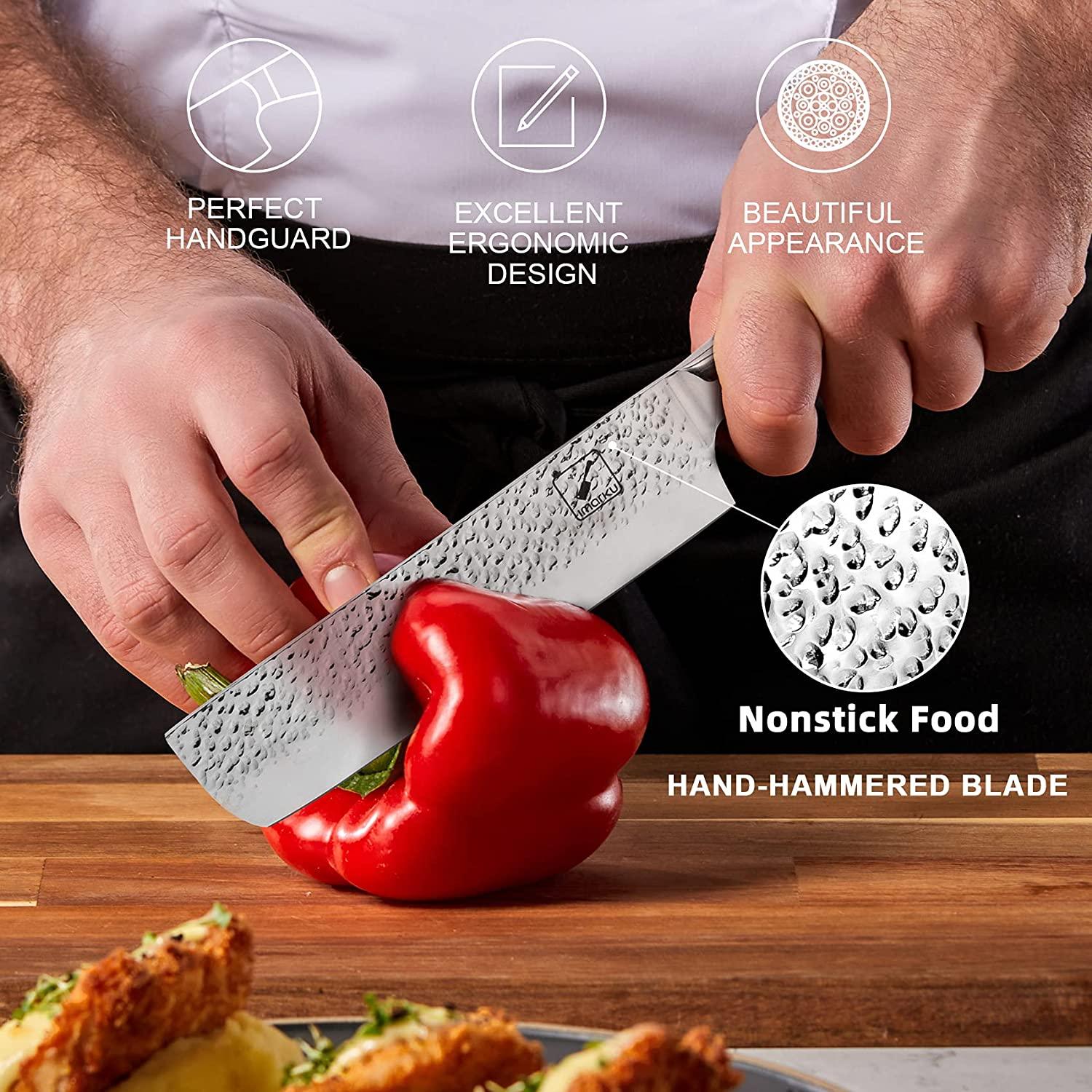TABLE OF CONTENTS
What is a Boning Knife?
Simply put, it is a sharp-pointed kitchen knife with a narrow blade. Usually, the length of a boning knife is 12-17cm. The reason why it has a narrow blade is to make boning precise and more accessible. Other kitchen knives have thick blades.
Generally, a stiff boning knife is ideal for boning pork and beef. On the other hand, a flexible boning knife is best suited for boning fish and poultry. The blade has a perfect design for cutting through connective tissue and ligaments to remove meat from the bone effectively. The sharp tip makes it easier and safer to pierce meat.
It’s interesting to note that a boning knife has to be very sharp, and if you want to maintain its sharpness for long, the blade has to be tough. A dull blade does not slice meat from the bone. Instead, it rips it, which ends up affecting your cooking and presentation. Another disadvantage of a dull boning knife is applying more force to penetrate through the meat. This can cause you to lose control of the boning knife, which is extremely dangerous.
What Is It Used For?
In case you’re wondering how to use a boning knife, it’s worth noting that there are several ways you can use it in your home.
· Preparing meat
The first use is preparing meat. This is the primary use of a boning knife. If you’re preparing meat for cooking, a boning knife will come in handy. The design and flexibility of the blade allow you to cut through meat with ease. Also, the sharp tip makes it easier to break joints. For example, if you’re breaking chicken, a boning knife allows you to have different cuts. You can also use the knife to peel skin and fat from any meat. It’s flexible enough to peel fat and skin without carving the meat underneath.
· Preparing fruit
If you’re preparing fruit, you can also make use of a boning knife. It helps produce good results. The size and shape of the knife make it possible to peel the outer skin of fruits. For example, if you’re peeling off the skin of a pineapple, a boning knife will come in handy. It will help you to remove the outer layer without going too much underneath. In addition, if you want to have an attractive presentation of your fruits after preparation, a boning knife is the ideal tool for the job. If you use the wrong knife, you may end up carving away much of the pineapple. You’ll end up wasting your fruit. Therefore, it’s a brilliant idea to use this knife for fruit preparation.
· Carving baked foods
If you would like to carve your baked foods into different shapes and sizes, you can rely on a boning knife for the job. The thin blade comes in handy to help you make precise cuts. You can also use it to shape the edges of cakes, make layers even, or give cakes different shapes. Regardless of the type of cake, you’re baking, a boning knife will play a major role in shaping it and sharpening its edges.
Boning Knife vs. Fillet Knife
There are similar features between a boning knife and a fillet knife, especially in terms of shape and size, but there are significant differences. It’s essential to have a good understanding of both knives so that you use them to their fullest potential.
· Purpose
The first difference has to do with the purpose for each. Having figured out how to use a boning knife, you know that you need it when you’re slicing meat from the bone. If you have to cut through connective tissue, muscle, and fat, you need a boning knife. In short, it’s the knife for the demanding job. However, a fillet knife doesn’t do a tough job like a boning knife. A fillet fish works well when you’re cutting meat from the skin and bone of fish. To get optimal results from each knife, make sure that you’re using them for their common purposes.
· Weight of Blade
If you look closely, you’ll find out that there is a difference between boning and fillet knives regarding weight. A boning knife is heavier than a fillet knife. Also, the blade of a fillet knife is thinner than that of a boning knife.
· Blade Flexibility and Rigidity
Boning knives are known to be more rigid, while fillet knives are more flexible. There is a reason for the flexibility and rigidity of both. A boning knife has rigid construction to allow it to remove meat from bones. It is tough penetrating through the connective tissue. So, the knife has to be rigid enough to do intended tasks. On the other hand, a fillet knife must be flexible to make precise cuts between fish and skin. Since it’s designed for delicate meat, the blade has to be flexible enough for the task.
· Blade Design
There is also a significant difference when it comes to the design of the blade. For a boning knife, you’ll notice that the blade is straight up to the sharp tip. This is to make it easier to pierce through the meat. A fillet knife isn’t like that. You’ll notice that a fillet knife has a curved blade. This design gives it the perfect shape for filleting fish.
How to Choose a Boning Knife
There are factors to consider when choosing a boning knife. The ideal knife depends on the meat you’re preparing. Here are the aspects to watch out for when choosing a boning knife.
· The Blade Design and Material
One of the things you have to put in mind when choosing a boning knife is the design and material of the blade. If you want one that will enable you to separate bones from fish, you’ll have to go for a curved blade. The curve will make it easier and effective to separate bones and skin from the meat. If you’re preparing delicate meat, you should choose a curved blade. On the other hand, if you’re preparing tough meat, you should choose a boning knife with a straight blade. With respect to the material of the blade, consider going for stainless steel.
· The Handle
Another aspect that’s important when choosing a boning knife is the handle. A handle carries a great deal of significance. Essentially, you should pick a boning knife with a handle that’s comfortable on your hand. Also, make sure you pick a handle with a firm grip. A firm grip will enable you to perform your tasks well for good results. If you have a knife with a quality handle, you’ll be able to maximize its potential.
It’s also imperative to consider the material of the handle. If you choose a wooden handle, you’ll have an appealing boning knife. However, the lifespan of the handle is reduced because of the wood’s level of brittleness. If you want a handle that will last longer, you can go for synthetic materials. Synthetic materials offer comfort, durability, and attractiveness.
· Level of Rigidity and Flexibility
The level of rigidity and flexibility in a boning knife depends on the tenderness of the meat you’re preparing. If you’re preparing tender meat, you’ll need a boning knife with a flexible blade. However, if you’re preparing tough meat, you’ll need to go for a boning knife with a stiff blade.
· Cost
The cost of a boning knife is also something you should put into consideration. Different brands have different prices for their knives. If you go shopping, you’ll find some being expensive while others being affordable. Of course, the cost goes hand in hand with the quality. Depending on your budget, you’ll be able to choose a boning knife that meets your needs in the best way possible.
How to Use a Boning Knife
For you to get the best from a boning knife, you should use it well. Whether you’re a professional chef or a general cook, it’s essential to learn how to use the knife well. This will enable you to use it to its optimal potential.
The first thing you need to know is that you should hold the knife with your dominant hand. To have a good grip on the knife, place your middle finger, ring finger, and thumb on the handle. Your index finger should be rested firmly on the blade. The purpose of this is to ensure that the motions of the knife are as stable as possible. The movements have to be stable for you to perform your tasks effectively.
Another important point when it comes to using the boning knife is safety. It would help if you always were careful when using this knife. Whether you’re cutting through tender or tough meat, make sure that you’re extra vigilant.

How to Clean a Boning Knife
Now that you already know how to use a boning knife, it’s also essential to clean it. After preparing meat, the knife will have accumulated dirt, and you’ll have to keep it clean. Like any other kitchen knife, you should clean a boning knife immediately after use and keep it dry. While most knives are made of stainless steel, which is resistant to rust, you should be careful to keep them dry. If the handle of a boning knife is made of wood, the chances are high that it could absorb water and cause warps and cracks if you fail to dry it well.
A good point of advice when you’re cleaning a boning knife is to make sure that the blade doesn’t point at you. It should point away from your body for obvious reasons. This is to avoid injury. Since the blade is sharp, it could end up cutting your skin if you’re not careful enough. Also, don’t scrub too quickly, as it could slip from your grip and end up cutting you. To reduce the risk of injuring yourself, you can place the knife on a countertop and wash it aside at a time.
If food is stuck on the knife, the best thing to do is soak it in water for a few minutes. This will make it easier to clean it. Remember not to soak the knife for more than 2 minutes. If you soak for more than 2 minutes, you risk your knife developing rust.
How to Sharpen a Boning Knife
Sharpening a boning knife is pivotal as it helps it to remain valid for a long time. The more you continue using your knife, the more it becomes dull. For this reason, you should keep monitoring it so that you sharpen it whenever necessary. Here are the steps to follow when sharpening a boning knife:
· Get a Whetstone for the Task
Set up and use a whetstone to sharpen your blade. A whetstone is a stone with different grits used to sharpening stones. For a boning knife, you need a fine grit to work on its sharpness.
· Position the Knife on the Whetstone
The second step is to position your knife on the whetstone. For a process that gets you the best results, the best angle to position the knife is a 12-20 degree angle on the whetstone.
· Sharpen from Side to Side
For best results, sharpen from one side to the other. The advantage of sharpening one side at a time is that you get to control the angles better. A sweeping motion is ideal to be in line with the contours of the blade.
· Rinse the Knife
After you’ve finished the sharpening process, make sure you rinse the knife. There is usually an accumulation of metal powder as a result of the sharpening process. This powder can quickly get into your food if you fail to rinse it off.
A boning knife has multiple uses that make it a valuable tool in the kitchen. Knowing how to use it well is a plus for the success of your kitchen tasks. If you use it well and care for it through proper maintenance, you’ll get the best out of it.


























Leave a comment
All comments are moderated before being published.
This site is protected by hCaptcha and the hCaptcha Privacy Policy and Terms of Service apply.